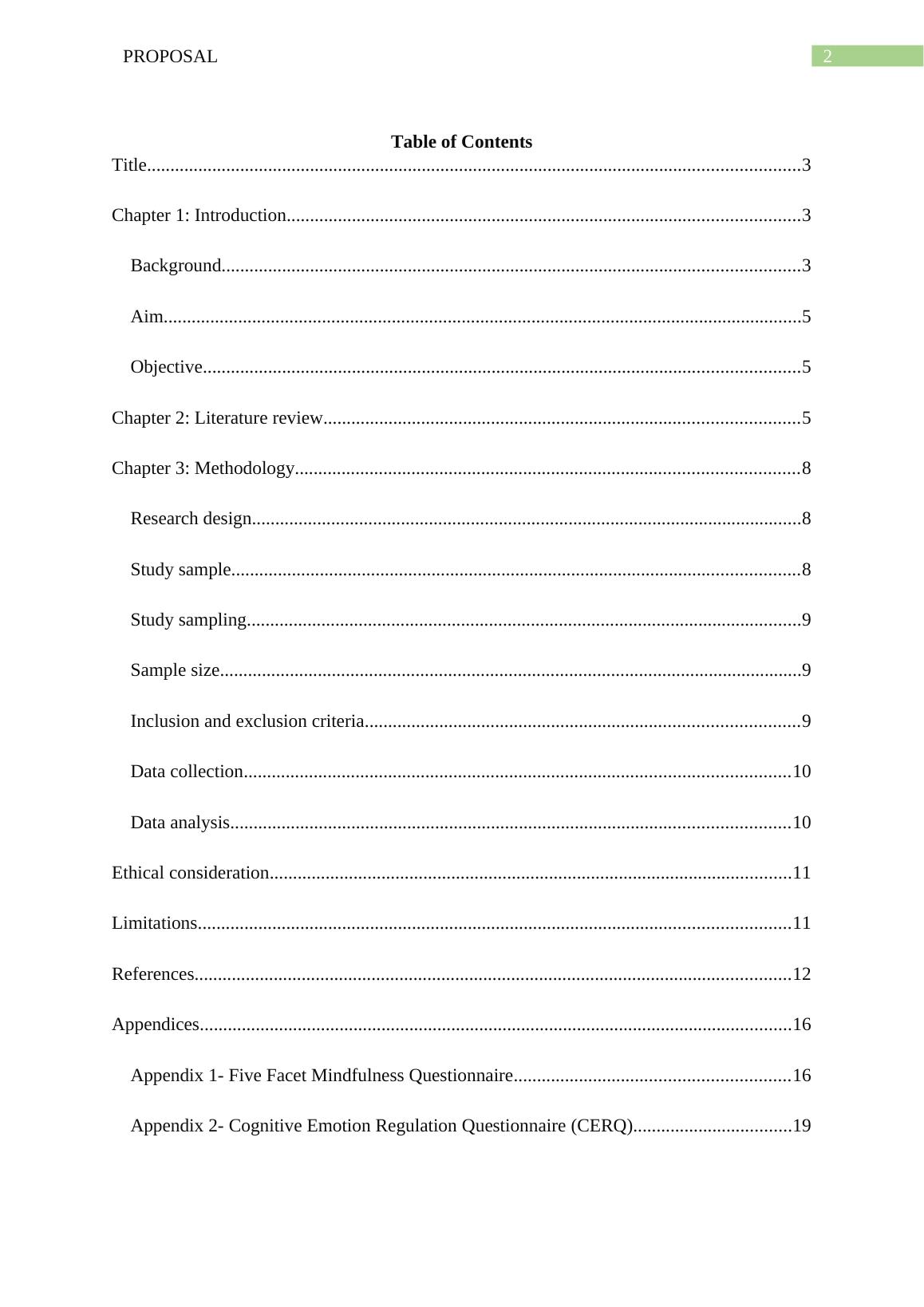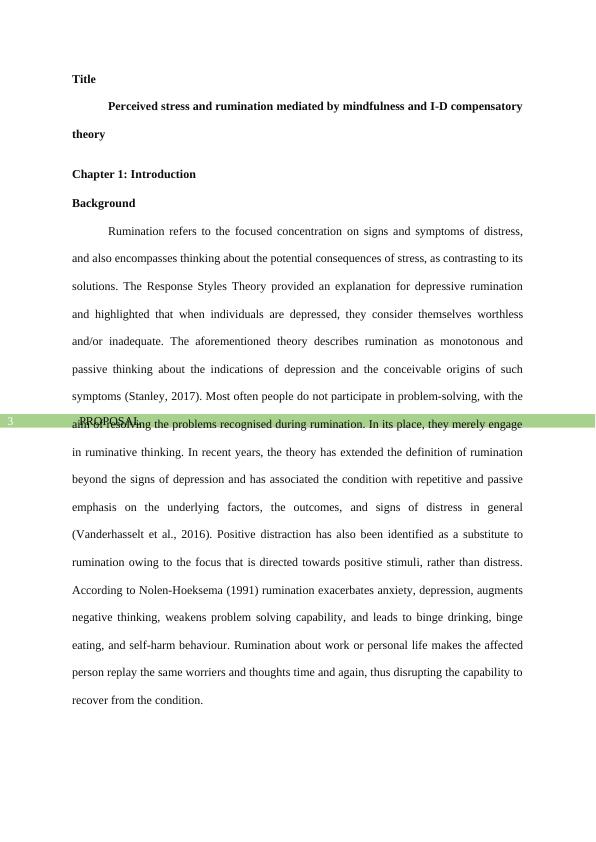Flexible Multidimensional Item Response Theory
Added on 2022-08-31
20 Pages4121 Words22 Views
Running head: PROPOSAL
Organisational psychology
Name of the Student
Name of the University
Author Note
Organisational psychology
Name of the Student
Name of the University
Author Note

PROPOSAL1
Abstract
Background- Stress has been identified as a matter of major concern all across the world.
Rumination is also associated with an exacerbation of psychological stress, which
deteriorates the capability of people to concentrate and solve problems, besides making them
more susceptible to self-harm, eating and drinking disorder.
Methodology- Cross-sectional study will be conducted amid employees or a travel
organisation. Convenience sampling will be followed for participant selection and their
responses for two questionnaires namely, Cognitive Emotion Regulation Questionnaire
(CERQ) and Five Facet Mindfulness Questionnaire will be collected during three phases that
are peak season, shoulder season, and off season.
Data analysis- SPSS software to be used for statistical evaluation of responses. Pearson’s
chi-square test will also be performed.
Keywords: rumination, stress, travel employees, cognitive emotion regulation questionnaire,
five facet mindfulness questionnaire
Abstract
Background- Stress has been identified as a matter of major concern all across the world.
Rumination is also associated with an exacerbation of psychological stress, which
deteriorates the capability of people to concentrate and solve problems, besides making them
more susceptible to self-harm, eating and drinking disorder.
Methodology- Cross-sectional study will be conducted amid employees or a travel
organisation. Convenience sampling will be followed for participant selection and their
responses for two questionnaires namely, Cognitive Emotion Regulation Questionnaire
(CERQ) and Five Facet Mindfulness Questionnaire will be collected during three phases that
are peak season, shoulder season, and off season.
Data analysis- SPSS software to be used for statistical evaluation of responses. Pearson’s
chi-square test will also be performed.
Keywords: rumination, stress, travel employees, cognitive emotion regulation questionnaire,
five facet mindfulness questionnaire

PROPOSAL2
Table of Contents
Title............................................................................................................................................3
Chapter 1: Introduction..............................................................................................................3
Background............................................................................................................................3
Aim.........................................................................................................................................5
Objective................................................................................................................................5
Chapter 2: Literature review......................................................................................................5
Chapter 3: Methodology............................................................................................................8
Research design......................................................................................................................8
Study sample..........................................................................................................................8
Study sampling.......................................................................................................................9
Sample size.............................................................................................................................9
Inclusion and exclusion criteria.............................................................................................9
Data collection.....................................................................................................................10
Data analysis........................................................................................................................10
Ethical consideration................................................................................................................11
Limitations...............................................................................................................................11
References................................................................................................................................12
Appendices...............................................................................................................................16
Appendix 1- Five Facet Mindfulness Questionnaire...........................................................16
Appendix 2- Cognitive Emotion Regulation Questionnaire (CERQ)..................................19
Table of Contents
Title............................................................................................................................................3
Chapter 1: Introduction..............................................................................................................3
Background............................................................................................................................3
Aim.........................................................................................................................................5
Objective................................................................................................................................5
Chapter 2: Literature review......................................................................................................5
Chapter 3: Methodology............................................................................................................8
Research design......................................................................................................................8
Study sample..........................................................................................................................8
Study sampling.......................................................................................................................9
Sample size.............................................................................................................................9
Inclusion and exclusion criteria.............................................................................................9
Data collection.....................................................................................................................10
Data analysis........................................................................................................................10
Ethical consideration................................................................................................................11
Limitations...............................................................................................................................11
References................................................................................................................................12
Appendices...............................................................................................................................16
Appendix 1- Five Facet Mindfulness Questionnaire...........................................................16
Appendix 2- Cognitive Emotion Regulation Questionnaire (CERQ)..................................19

PROPOSAL3
Title
Perceived stress and rumination mediated by mindfulness and I-D compensatory
theory
Chapter 1: Introduction
Background
Rumination refers to the focused concentration on signs and symptoms of distress,
and also encompasses thinking about the potential consequences of stress, as contrasting to its
solutions. The Response Styles Theory provided an explanation for depressive rumination
and highlighted that when individuals are depressed, they consider themselves worthless
and/or inadequate. The aforementioned theory describes rumination as monotonous and
passive thinking about the indications of depression and the conceivable origins of such
symptoms (Stanley, 2017). Most often people do not participate in problem-solving, with the
aim of resolving the problems recognised during rumination. In its place, they merely engage
in ruminative thinking. In recent years, the theory has extended the definition of rumination
beyond the signs of depression and has associated the condition with repetitive and passive
emphasis on the underlying factors, the outcomes, and signs of distress in general
(Vanderhasselt et al., 2016). Positive distraction has also been identified as a substitute to
rumination owing to the focus that is directed towards positive stimuli, rather than distress.
According to Nolen-Hoeksema (1991) rumination exacerbates anxiety, depression, augments
negative thinking, weakens problem solving capability, and leads to binge drinking, binge
eating, and self-harm behaviour. Rumination about work or personal life makes the affected
person replay the same worriers and thoughts time and again, thus disrupting the capability to
recover from the condition.
Title
Perceived stress and rumination mediated by mindfulness and I-D compensatory
theory
Chapter 1: Introduction
Background
Rumination refers to the focused concentration on signs and symptoms of distress,
and also encompasses thinking about the potential consequences of stress, as contrasting to its
solutions. The Response Styles Theory provided an explanation for depressive rumination
and highlighted that when individuals are depressed, they consider themselves worthless
and/or inadequate. The aforementioned theory describes rumination as monotonous and
passive thinking about the indications of depression and the conceivable origins of such
symptoms (Stanley, 2017). Most often people do not participate in problem-solving, with the
aim of resolving the problems recognised during rumination. In its place, they merely engage
in ruminative thinking. In recent years, the theory has extended the definition of rumination
beyond the signs of depression and has associated the condition with repetitive and passive
emphasis on the underlying factors, the outcomes, and signs of distress in general
(Vanderhasselt et al., 2016). Positive distraction has also been identified as a substitute to
rumination owing to the focus that is directed towards positive stimuli, rather than distress.
According to Nolen-Hoeksema (1991) rumination exacerbates anxiety, depression, augments
negative thinking, weakens problem solving capability, and leads to binge drinking, binge
eating, and self-harm behaviour. Rumination about work or personal life makes the affected
person replay the same worriers and thoughts time and again, thus disrupting the capability to
recover from the condition.

End of preview
Want to access all the pages? Upload your documents or become a member.